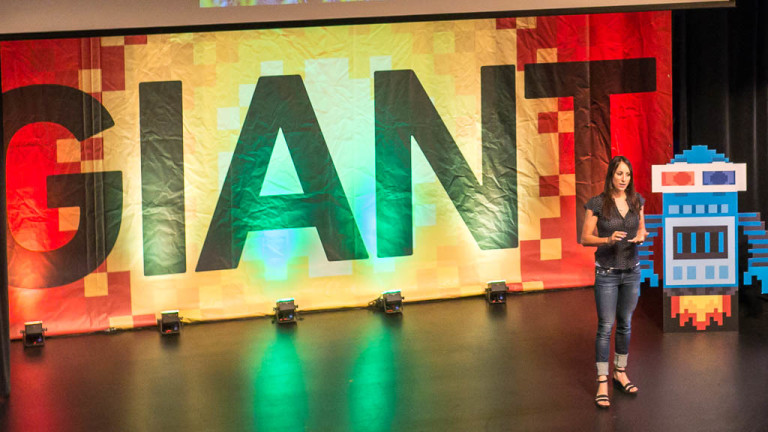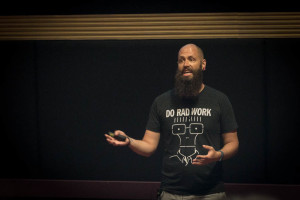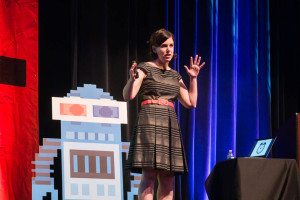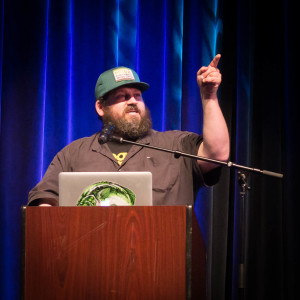Totally taking onboard one of the themes from Giant Conf 2015 with these notes: “Don’t be perfect.” These notes are far from perfect, but I know that if I don’t get them out right now, they’ll be forever lost in Evernote. So here they are in all their raw, unperfected beauty.
You can read my notes from sessions by Scott Berkun, Kevin Hoffman and more.
And more notes here, from Jaimee Newberry, Denise Jacobs plus more.
Why Linus needs to Ditch his Blanket; Hacking beyond the perimeter of the comfort zone – Sonya Looney
The general gist: Go on an adventure and challenge yourself outside of your comfort zone. The more you do it the more you will learn, grow, and feel alive.
- Children have a security blanket because it makes them feel safe, brings comfort, relieves anxiety.
- What is your security blanket?
- Your “safe place” can be where you go to recharge, but it can also be a prison.
- Your attitude is the difference between an ordeal and an adventure – Bob Bitchin
- Life begins at the end of your comfort zone
- I can accept failure, everyone fails at something. But I can’t accept not trying again – Michael Jordan
- Children are naturally curious, aren’t afraid to chase their dreams, see the funny side of situations, and are brutally honest.
- Kids in poverty can still laugh. Find the fun in everything you do, even when things aren’t going perfectly.
- You will either step forward into growth, or step backwards into safety.
- There’s no heavier burden than a great potential. – Linus
- It takes a lot of work and commitment to be great at something.
- At the end of your life you don’t want to say, “I could have”, say, “I did”.
- Decide not to be perfect – aspire to be better not perfect.
- What is failure? Failure is giving up. Failure is not trying.
- Focus on why you can do somethings, not why you can’t
- Attitude is a choice, being positive is a choice. Misery is optional
- Cherokee Fable: http://www.nanticokeindians.org/tale_of_two_wolves.cfm
Discussing Design without losing your mind – Adam Connor
The general gist: Critiques are an important part of the communication process in design. It goes beyond just providing feedback. It’s a skill that takes practice.
- Feedback is a broad concept.
- There are different types of feedback:
- Reaction e.g. “Good lord! That’s horrible!” This doesn’t tell us much about the objectives.
- Direction e.g. “You should have done this…” This takes a bit more thought, but it jumps to solutions.
- Critique – This includes objectives and connects it with something in the design and presents a solution.
Rules of Critique
- Avoid problem solving – by diving into problem solving you miss the chance to gather ideas from a brainstorm.
- Everyone is equal
- Everyone is a critic – get everyone to speak up. Quiet people can throw off the dynamic because you don’t know what they are thinking and they may take those thoughts outside of the meeting.
- The person being critiqued is responsible for the next steps
- Goal is to identify opportunities for improvement
- Lead a critique with questions. Questions will remove assumptions and creates conversation.
- Some sample critique questions:
- What was the creator trying to achieve?
- What choices did they make to try to get there?
- How did they try to achieve it?
- How effective were their choices?
- Why is or isn’t what they did effective?
Standalone Critiques
- Critiques don’t have to be formal.
- It should be part of an iterative process to improve the design
- Invite people from different roles to give critique
- Less than 6 people, less than an hour.
- Active listening – repeat back as you understood it.
- Round robin & quotas
- De Bono: 6 Thinking Hats: http://www.debonogroup.com/six_thinking_hats.php
Design Reviews With Clients
- They are difficult, because you’re looking to “sign off” on the design.
- If the client doesn’t see what they want, they will give a checklist of revisions. This goes against everything in a critique e.g. not focused on objectives.
- Try to get useful feedback from clients. Always reiterate goals and objectives.
- Take control of the presentation.
- Take the opportunity to set the stage and frame the conversation and recap objectives that were defined.
Set Foundations
- Agree on Personas – the user archetypes that you’re designing for.
- Goals
- Principles
- Scenarios – stories that include a use case and persona, thoughts and feelings as they move through the sequence of interactions.
Building an innovation program that engages employees and executives – Michele Marut
The general gist: Most companies don’t allocate time for innovation. Employees feel like they don’t have time to invest in new ideas. Executives don’t know how to evaluate ideas. AutoDesk created an Innovation Program that involves a “Lunch’n’Learn” with pizza, and applying learnings to a real project.
The problem:
- Employees pitch new ideas to executives
- Execs have budget constraints in mind
- Execs didn’t know how to evaluate ideas
- There is no existing framework for innovation beyond the product roadmap
- Executives felt threatened, because new ideas could take resources away from their projects.
The solution:
- Lunch n Learn with pizza
- Watch videos of available conference presentations
- Created a self service website for international employees to watch videos
- Coaching and office hours were available for follow up learning
Use Your Experience – Sandy Culver Plemmons
The general gist: Your skills could be of huge value to nonprofits looking to make a difference in the world. All small nonprofits struggle with budget and time to do anything properly when it comes to design and digital marketing. Build bridges where others see holes. Use your talents to make a difference.
Designing What Matters – Elizabeth Eadie
The general gist: You can benefit from being an outsider to your industry. In places where design isn’t prevalent, find ways to rock the boat. Start slow and see what people will tolerate.
- Teach everything that you know. Teach others how to appreciate design.
- If you’re not asked to speak, you should ask to speak
- Adopt allies in your company, people who are receptive to your ideas.
- Hire the best people that you can get your hands on.
- Fill your gaps, fill your blind spots
- Hire people better than you.
- Don’t hold back on teaching everyone
- Make a ripple, teach other people to ripple.
Wicked Ambiguity – Jonathon Colman
- There is no such thing as perfect. Stop being perfect. Perfection is a barrier to our progress and creativity.
- Fail as often and as quickly as we can.
- Reward learning, stop punishing failure.
Graphic Treasures From the American Underbelly – Aaron Draplin
The general gist: Aaron covered a familiar theme of seeking out amazing design from unlikely places. Learn from simple, timeless design pieces. Do things for the right reasons (not money). Make things you love and it will pay off in the end.
The session was too much of a spectacle for me to take notes. Aaron is the type of personality that the design world needs. A true master of the humblebrag.



